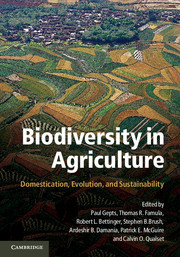Book contents
- Frontmatter
- Contents
- Tables
- Figures
- Foreword
- Contributors
- Acknowledgments
- Introduction: The Domestication of Plants and Animals: Ten Unanswered Questions
- 1 The Local Origins of Domestication
- Section I Early Steps in Agricultural Domestication
- Section II Domestication of Animals and Impacts on Humans
- Section III Issues in Plant Domestication
- Section IV Traditional Management of Biodiversity
- 17 Ecological Approaches to Crop Domestication
- 18 Agrobiodiversity Shifts on Three Continents Since Vavilov and Harlan: Assessing Causes, Processes, and Implications for Food Security
- 19 Indigenous Peoples Conserving, Managing, and Creating Biodiversity
- 20 Land Architecture in the Maya Lowlands: Implications for Sustainability
- 21 Agrobiodiversity and Water Resources in Agricultural Landscape Evolution (Andean Valley Irrigation, Bolivia, 1986 to 2008)
- Section V Uses of Biodiversity and New and Future Domestications
- Index
- References
20 - Land Architecture in the Maya Lowlands: Implications for Sustainability
Published online by Cambridge University Press: 05 June 2012
- Frontmatter
- Contents
- Tables
- Figures
- Foreword
- Contributors
- Acknowledgments
- Introduction: The Domestication of Plants and Animals: Ten Unanswered Questions
- 1 The Local Origins of Domestication
- Section I Early Steps in Agricultural Domestication
- Section II Domestication of Animals and Impacts on Humans
- Section III Issues in Plant Domestication
- Section IV Traditional Management of Biodiversity
- 17 Ecological Approaches to Crop Domestication
- 18 Agrobiodiversity Shifts on Three Continents Since Vavilov and Harlan: Assessing Causes, Processes, and Implications for Food Security
- 19 Indigenous Peoples Conserving, Managing, and Creating Biodiversity
- 20 Land Architecture in the Maya Lowlands: Implications for Sustainability
- 21 Agrobiodiversity and Water Resources in Agricultural Landscape Evolution (Andean Valley Irrigation, Bolivia, 1986 to 2008)
- Section V Uses of Biodiversity and New and Future Domestications
- Index
- References
Summary
The Anthropocene (Crutzen and Stoermer 2001) signifies the elevation of humankind to a force of environmental change equivalent to nature, capable of affecting ecosystems, including the Earth system (Steffen et al. 2003). While overwhelming attention has been given to this role in climate change (IPCC 2007), the human impress on the environment is registered throughout the Earth system, especially in regard to the configuration of the terrestrial surface of the Earth (Turner et al. 1990). Humankind matches, and in some instances, exceeds nature in determining the land covers of the Earth, and in this role is a large factor in the structure and function of the environment (Vitousek et al. 1997). Indeed, anthropogenic biomes (or coupled human–environment systems) dominate about 75% of the ice-free land surface (Ellis and Ramankutty 2008), appropriating about 25% of terrestrial net primary production (Haberl et al. 2007). They change the capacity of the land system to deliver environmental (ecosystem) services (MEA 2005), often with consequences for human uses and livelihoods.
Such change and consequences have long been mimicked at subglobal scales, with highly differential outcomes for human–environment relationships (Thomas 1956, Turner and McCandless 2004). Some coupled land systems have been operating since antiquity, including certain intensive wet rice systems of cultivation that have been in place 4,500 years (Crawford and Shen 1998). Others have fundamentally altered the delivery of environmental services to which the human subsystem has adapted, such as the Mediterranean rimlands (Butzer 2005, McNeill 1992). Yet other coupled systems have failed, especially those involving intensive resource use on small islands or inappropriate water management in arid lands, with and without climate change (Tainter 1988, Redman 1999, Diamond 2005).
- Type
- Chapter
- Information
- Biodiversity in AgricultureDomestication, Evolution, and Sustainability, pp. 445 - 463Publisher: Cambridge University PressPrint publication year: 2012
References
- 2
- Cited by



